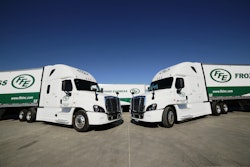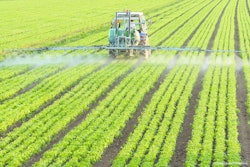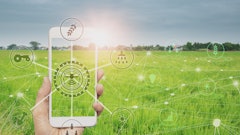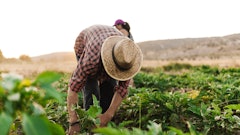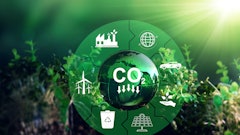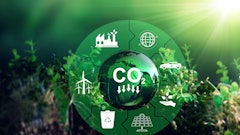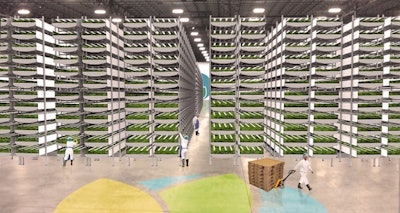
Sustainability and protecting the environment have, of course, been in the news for a while. Driven primarily by consumers who want healthier food that doesn't damage their surroundings, sustainability is having a profound effect on the global food supply chain.
On its website, the WWF—originally known as the World Wildlife Fund—says, “By 2050, the world’s population will reach 9 billion, the global middle class will grow from 2 to almost 6 billion, and the consequent demand for food may at least double. So how can we produce enough and good quality food for all these people without destroying the planet, and jeopardize our future?”
It’s a great question. And many of the answers can be found along the complex, ever-evolving supply chain. From farm to fork, from seedling to store, here’s a look at some of the ways that transportation and logistics providers are making a difference—and often finding that sustainability can lead to increased efficiency and a better bottom line.
On the Farm
Farmers are using a number of methods, including water conservation, renewable energy sources, more efficient use of non-renewable sources and the newest, though still a bit controversial, trend—vertical farming.
In his 2010 book, “The Vertical Farm: Feeding the World in the 21st Century,” Dickson Despommier, Ph.D., emeritus professor of microbiology and public health at Columbia University, wrote: “Vertical farms are immune to weather and other natural elements that can abort food production. Crops can be grown under carefully selected and well-monitored conditions that ensure optimal growth rates for each species of plant and animal year-round. In other words, there are no seasons indoors. The efficiency of each floor of a vertical farm, one acre in footprint, could be equivalent to as many as 10 to 20 traditional soil-based areas, depending upon the crop. Vertical farms offer many environmental benefits as well. Farming indoors eliminates the need for fossil fuels now used for plowing, applying fertilizer, seeding, weeding and harvesting.”
No one thinks of New Jersey as a hotbed for farming, but in an abandoned steel mill in Newark—about as urban as you can get—leafy greens such as spinach, arugula and kale are being grown in vertical stacks without soil, without water and without sunlight. The company behind vertical farming, AeroFarm, has so far invested more than $30 million into the project, using a technology called aeroponics.
A large growing container about 20 feet high contains seven tiers of growing beds about 20 feet in length. Above each bed are columns of LED lights, taking the place of natural light that the plants photosynthesize. The growing medium is a microfleece membrane, and a nutrient-rich mist beneath the reusable cover keeps the plants moist.
Opponents, however, cast doubts on whether the trend can be financially viable as well as productive enough to cut deeply into the worldwide hunger problem.
So what else is going on down on the farm?
Probably the No.1 concern is water. Farms are moving from what’s known as flood irrigation to drip irrigation and spray irrigation, more selective ways of watering the crops and conserving water.
According to the U.S. Geological Survey (USGS) Water Science School, about 39 percent of all the fresh water used in the United States goes to irrigate crops. After use, much of this water cannot be reused because it evaporates and transpires in the fields. And, the USGS points out, “if you consider that the majority of irrigation occurs in the western United States, where water is relatively scarce, you can see how important it is for farmers to find the most efficient methods of using their irrigation water.”
There are ways to help. Leveling of the fields means that water will flow evenly and not downhill, missing crops and being wasted. Surge flooding also can be used. Instead of just flooding the field haphazardly, water is released at scheduled intervals to reduce runoff. Finally, farmers are recapturing runoff in ponds and pumping it back to where it can be reused in the next cycle of irrigation.
Installing drip or spray irrigation systems, while more expensive in the beginning, can pay dividends in the long haul. Drip irrigation is very efficient for fruits and vegetables. Water is sent through plastic pipes with holes in them, saving around 25 percent of the water used in flood irrigation, says the USGS.
Large-scale spray irrigation systems are in use on large farms. These systems have a long tube fixed at one end of the water source, such as a well. Water flows through the tube and is shot out by a system of spray guns. The USGS describes it as “similar to the way you might water your lawn at home—stand there with a hose and spray the water out in all directions. The systems can simply be long hoses with sprinklers along the length or a center-pivot system that traverses a circle in the fields.”
Technology also is playing a role, says Tim Feemster, managing principal of Foremost Quality Logistics in Dallas. “Verizon is doing a test program at some of the wineries in the Monterey (California) area. They put sprinkler systems in the vineyards and telemetry in the ground to measure moisture, and turn it on only where needed. It really saves water. The technology is there. With IoT (Internet of Things) today, it allows much more data to be more efficient.”
Gregory Brun, senior Viticulturist at Delicato Family Vineyards, one of three wineries using the system, adds, “As an irrigation tool, the solution is not only economical and scalable, it gives growers an integrated view of the vines’ water needs to improve quality and drive sustainability. It’s one of the most rational approaches based on water constraint evaluation.”
Transportation and Distribution
Transportation is a key element in any supply chain, of course, but it takes on added importance in the food and beverage industry, especially with products that must be refrigerated. Ginsberg’s Foods, an independent food distributorship in Hudson, New York, can serve as a microcosm for how an efficient transportation management system (TMS) cannot only greatly reduce its carbon footprint, reduce emissions and more, but also improve the bottom line.
Family owned since beginning as a local grocery store in 1909, Ginsberg’s has 35 trucks that cover more than 30,000 miles per week in six northeaster states. Like most food distributors, Ginsberg’s Foods has used traditional fixed route dispatch and routing practices, delivering loads to the same customers the same day each week. The system was complicated because many customers don’t have standing orders, and many of them require the distributor to adhere to a four-hour delivery window.
In 2015, the company decided that a dynamic routing system that would account for orders and delivery windows, while being fully integrated with onboard communications technology, was necessary to manage and monitor deliveries by account on a real-time basis.
After a review, Ginsberg’s selected TMW Systems, a Cleveland-based transportation software provider to commercial and private fleets, brokerage and 3PLs. TMW, a Trimble Company, serves more than 2,000 customers, including many of the largest, most sophisticated and complex transportation service companies in North America.
Ginsberg’s replaced its legacy routing application with TMW’s Appian DirectRoute software to simplify fixed-route creation and management, and its DRTrack Operations solution to automate daily routing and enable mobile communication with drivers of each of the company’s 51 trucks. The also implemented PeopleNet Solutions, TMW’s sister company, for onboard technology, including real-time diagnostics and performance monitoring. The integrated solutions allow Ginsberg’s sales team to monitor delivery performance by account on a real-time basis to enhance customer communication and satisfaction.
“The Appian solutions are much more user-friendly than our [legacy] software, and offer significantly greater visibility and control for our dispatcher,” says Larry Bigando, transportation manager, Ginsberg’s Foods. “We [are] able to compare various routing options and their corresponding costs, so we can make better, faster decisions that benefit our customers and our bottom line.”
The rollout was done in three phases. Phase one included the implementation of routing and dispatch software. Phase two involved upgrading the onboard systems with PeopleNet technology. Finally, in phase three, Ginsberg’s integrated handheld computers for point of delivery scanning. The process began in November 2016 and was fully operational on March 1, 2017.
The results were almost immediate, Bigando says. Comparing March 2017 to March of the previous year, delivery stops were up 5 percent, cases per route up 2 percent, stops per route up 6 percent, routes per day down 4 percent and miles driven down 6.7 percent.
The distributor is on track to save more than $571,000 annually, and recover its technology investment by the end of the first year of operation.
Technology is playing a large role to route trucks. It enables multi-load LTLs (less than truckload) and pool distribution. People are able to combine orders and make deliveries earlier, adds Foremost Quality’s Feemster.
Warehouses and DCs
The energy it takes to heat, cool and light a large food warehouse or distribution center is enormous—even more for cold and frozen storage than dry goods.
“Being able to minimize energy in cold storage is a big deal,” says Feemster. “If they can do that, it’s a huge advantage in cost and pricing. And it’s good for the environment. Inside cold storage is going to LED lighting. It’s energy efficient and doesn’t generate heat. In the old environment, there was no choice—they had to have light. There also are motion sensors, so areas that aren’t in use won’t be wasting energy on lighting.” On the dry side, many companies also are going to LED lighting or T5 or T8 fluorescent bulbs, which come with one-third lower energy costs, he adds.
Yusen Logistics, a New Jersey-based 3PL, has completed an LED retrofit that will reduce electricity usage and expense by more than 60 percent at one of its Carson, California, warehouses. The company replaced 966 outdated fixtures with LEDs at the 486,000 square foot facility. The change is expected to reduce energy use on average by one million kilowatt hours (kWh), and decrease power consumption by as much as 65 percent over the previous year.
Atlanta-based Americold Logistics is a temperature controlled warehousing and transportation company specializing in the storage of perishable goods. Energy consumption is a vital part of what they do, says Daniel Cooke, director of marketing.
“We’re always looking at the most appropriate, most socially responsible practices to implement that still ensure that we can offer the temperature-controlled services our customers need. We install motion-sensing LEDs in tacitly upgrades and new build plans, and we include fast-closing doors to keep air temperatures more constant.”
Forty-five Americold sites have been fitted with activated LED lighting systems that illuminate as-needed and switch off automatically when personnel leave. That saves more than 14 million kWh per year. Forty-two of the company’s sites have completed Cascade Energy system tune-ups to assess and fine-tune refrigeration system operations.
“We take part in every demand response program offered in the United States,” Cooke explains. “When utility companies are expecting heavy power draws, they will reach out and ask us to reduce our own power draw. Our facilities are so well insulated that we’re able to reduce our power need for a facility for a period of time without affecting conditions in our cold rooms. This means that utility companies may not need to fire up additional power stations, many of which are coal-burning, and so we reduce overall power generation needs.”
With its sustainability initiatives, including solar power generation at a Massachusetts facility (generating up to 500,000kWh of clean energy yearly) and a turbine generator in Salinas, California, that generates up to 600,000 kWh of clean energy each year from a natural gas fuel cell. Cooke says Americold has saved 320 million kWh since 2010. That translates into 264 million pounds of CO2 equivalents that were not released into the atmosphere.
Finding sufficient warehouse space also is a concern. Too big? Too small? Too far from customers? The latest solution is called FLEXE, an online marketplace for on-demand warehousing solutions. The platform connects shippers who need warehouse space and services with warehouse providers that have excess capacity and resources. FLEXE currently has more than 500 warehouse partners in North America. The system is designed to help with inventory overflow and fulfillment needs.
Adds Feemster, “You’ve got some more local 3PLs willing to do multi-client facilities. Technology and WMS allows multi-tenant inventory management. Small- and medium-size companies in the grocery 3PL space will combine multiple orders to a single distribution, maybe ship three or four [brands] to the Kroger warehouse at once.”
Moving around the warehouse, forklifts also are playing their part in going green. Hydrogen fuel cells, which don’t generate heat are more efficient than the former systems. They can stand cold air in a freezer or refrigerated unit, and they’re easily and quickly refilled.
On the Fork
The Food Policy Research Center says that about 40 percent of the United States food supply is never eaten, among the highest rates of food loss globally. At 1,500 food calories lost per person per day, that is double most other industrialized nations and 50 percent more than was lost in the 1970s.
“Producing food uses resources and causes environmental impacts, such as water pollution, soil erosion and greenhouse gas emissions,” the FPRC report says. “Discarding food drains the food supply in a world with a growing demand.”
According to the Grace Communications Foundation, only 3 percent of food is composted in the United States. As a result, uneaten food is the single biggest component of municipal solid waste. In landfills, food gradually breaks down to form methane, a greenhouse gas that's at least 25 times more powerful than carbon dioxide. (Grace develops strategies to increase public awareness of the critical environmental and public health issues created by the current industrial food system and to advocate for more sustainable alternatives.)
Consumer food waste also has serious implications for energy usage. A study by the consulting group McKinsey found that, on average, household food losses are responsible for eight times the energy waste of farm-level food losses due to the energy used along the food supply chain and in preparation. In addition, food production releases hundreds of millions of pounds of pesticides into the environment each year and is the leading cause of fresh water pollution.
Here are some other relevant statistics from Grace:
- In the United States, an average family of four wastes 1,160 pounds of food annually (about 25 percent of the food they buy), costing them $1,365 to $2,275 per year.
- The average American throws away between $28 and $43 in the form of about 20 pounds of wasted food each month.
- Irrigation used to grow food that is thrown away could meet the domestic water needs of nine billion people.
- One year of food lost on the farm also equals about 300 million barrels of oil.
Clearly, the work is not done. And that’s from farm to fork.





